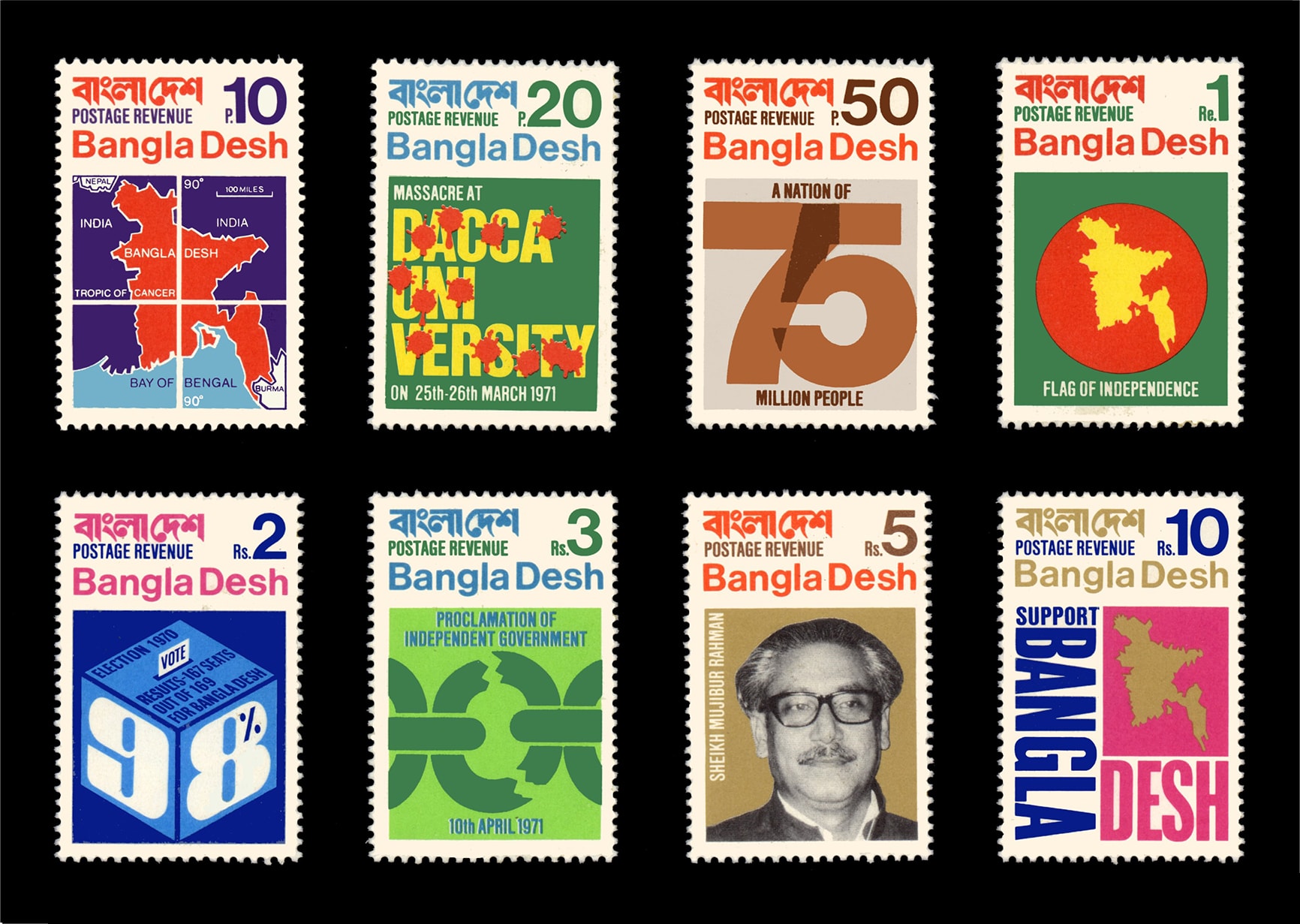The year 1971 was when Bangladesh was born, from the womb of extended strife and struggle. On April 10, Bangladesh declared independence. On July 26, a set of eight Bangladesh stamps was displayed to the international media in London. On July 29, before the fledgling nation won international recognition, Bangladesh — formerly East Pakistan — took the first step towards declaring its independence from Pakistan by issuing the eight stamps simultaneously in all metros, the world over. On December 16, 1971, the Pakistani army left Bangladesh.
These dates are well known, but few remember that those stamps were designed gratis by Biman Chand Mullick, a Howrah-born graphic designer, who had moved to London in 1960 and became a citizen of the UK 29 years later.

The first set of Bangladesh stamps designed by Biman Mullick Sourced by The Telegraph
Mullick has yet another notable achievement. In 1969, his design for the Gandhi Centenary Year stamp became the winner. This was the first British stamp to commemorate an overseas leader and the first designed by a foreign artist.
Londoners should not be surprised if they find this wiry, ever-smiling artist (born 1933), who turned into a long-distance runner at 50, running across snow-covered parks. Mullick has run distances across all the seven continents “but just for the fun and passion of it” and completed the 26.2 mile London Marathon at 72. When I called him on a Sunday morning, he was about to leave for a power walk. It was snowing.
A widower — he lost his wife, Aparajita, in 2020 — Mullick lives alone in Honor Oak Park. His daughter lives close by. Apart from being fitness conscious — he campaigned tirelessly to stop smoking in educational institutions, and ultimately in 2008 a law was passed banning it — he also feels strongly about the environment and its abuse. In 1971, he launched the Clean Air campaign for which he won a WHO award in 1988 along with Fidel Castro and Jimmy Carter.
His father, Ajit Kumar, was a Congress leader and a freedom fighter from Howrah, and Gandhiji, like other eminent political leaders such as Jawaharlal Nehru (in 1942), had visited his house when he was an infant in 1934.
Mullick’s grandfather, Dharani Dhar, who became a wealthy man from humble beginnings, started celebrating Durga Puja at his Joynarayan Babu Ananda Dutta Lane house in Howrah in 1902, and the tradition has still been kept alive by his descendants.
Mullick, who is one of 11 siblings, went to the school set up by his father in his own house. At a young age, he became an accomplished self-taught artist. He was not much interested in higher studies and scraped through college. His interests lay elsewhere — poetry, literature and art. He enjoyed his loneliness when he sojourned for three-four years at the family-owned Kaolin mines in Bhonda (now in Jharkhand). This was during the Quit India movement and the Japanese bombing scare in Calcutta during World War II. Mullick also loved editing his college magazines and in 1954, on his own steam, he brought out a Durga Puja magazine titled Kakoli. Equally at home in his vernacular and English, Mullick contributed an article in Bengali to the souvenir celebrating the centenary of his family Durga puja in 2002, and in 2016 he published his memoirs titled Durer Durga.
Mullick worked for some time at his uncle’s office, where, as the self-appointed advertising manager, he had created some ad campaigns. When he failed to land jobs in Calcutta, he was somehow convinced that the UK was just the place for him. So he set sail and landed in London with £2 in hand. He joined the St. Martin’s School of Art, where he was selected from among other applicants. Since he was already a skilled draughtsman, the four-year course was condensed to two. Two years later, he was told he would have to complete all four. He wasn’t even considered for the grant others enjoyed. He had to work as a porter at J. Lyons & Company, a well-known tea house, in the evenings to pay his fees. Of the 27 students, three passed. Mullick stood first. “Perhaps because of my originality,” he comments.
He hitchhiked to Geneva and worked in a design studio. His old friend, litterateur Sunil Gangopadhyay, met him there. But soon enough he chucked his job as it wasn’t challenging enough.
Back in London in 1964, Oxford University Press sought him out to illustrate a book titled India and Her Neighbours. Flush with the fortune he made — £750 — he returned to Howrah in 1966, got married and was back in London a year later with his wife Aparajita. Between jobs, in 1969 the Post Office asked him to join a competition to design a Gandhi stamp. His entry featured the Indian Tricolour in the background. His design was the winner.
Mullick illustrated the book Myths and Legends of India while teaching at an art school. In 1971, John Stonehouse, who was the postmaster-general of the UK, in the presence of Bangladesh spokesman Justice Abu Sayeed Chowdhury, requested Mullick to design without a fee the first postage stamps of the country that was birthing. Mullick had only three months in hand, but when he showed the designs to Stonehouse and Chowdhury, the former quipped, “You are a Gentleman.”
Chowdhury was referring to the English artist and very prolific designer of 103 British stamps — David Gentleman.
